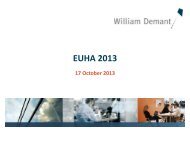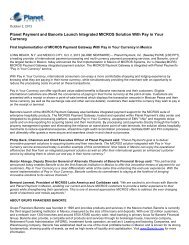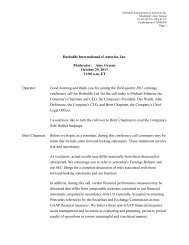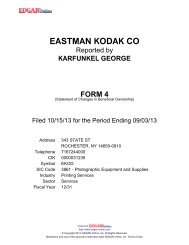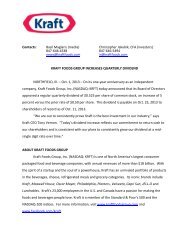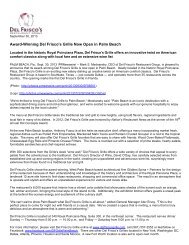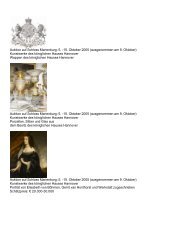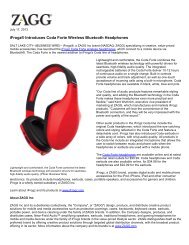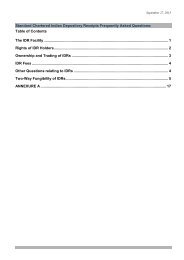Hypercom Corporation Annual Report - CiteSeer
Hypercom Corporation Annual Report - CiteSeer
Hypercom Corporation Annual Report - CiteSeer
You also want an ePaper? Increase the reach of your titles
YUMPU automatically turns print PDFs into web optimized ePapers that Google loves.
Allowance for Doubtful Accounts<br />
Payment terms for product and services trade receivables generally range from 30 to 90 days depending on the circumstances of<br />
each order or service contract. Any payments not received within the agreed upon due date are considered past due.<br />
The Company maintains an allowance for doubtful accounts for estimated losses resulting from the inability of its customers to<br />
make required payments. Such allowance is computed based upon a specific customer account review of larger customers and<br />
balances past due as well as a general reserve against individually smaller accounts receivable balances. The Company’s assessment<br />
of its customers’ ability to pay generally includes direct contact with the customer, investigation into customers’ financial status, as<br />
well as consideration of customers’ payment history with the Company. If the Company determines, based on its assessment, that the<br />
Company’s customers will be unable to pay, the Company will charge off the account receivables to the allowance for doubtful<br />
accounts. A rollforward of the activity in the allowance for doubtful accounts for the years ended December 31, 2009, 2008 and 2007<br />
is as follows:<br />
Balance at<br />
Beginning of<br />
Period<br />
Assumed in<br />
Acquisitions<br />
Provision<br />
(reversal) for<br />
doubtful accounts<br />
- 55 -<br />
Foreign<br />
Currency<br />
Impact<br />
Write-offs of<br />
uncollectible<br />
amounts<br />
Balance at<br />
End of Period<br />
(Dollars in thousands)<br />
Year Ended December<br />
31, 2009:<br />
Allowance for doubtful<br />
)<br />
)<br />
accounts<br />
Year Ended December<br />
31, 2008:<br />
$ 4,469 $ — $ (416 ) $ 280 $ (1,093 ) $ 3,240<br />
Allowance for doubtful<br />
)<br />
)<br />
)<br />
accounts<br />
Year Ended December<br />
31, 2007:<br />
$ 4,034 $ 5,046 $ (369 ) $ (852 ) $ (3,390 ) $ 4,469<br />
Allowance for doubtful<br />
)<br />
accounts $ 1,934 $ — $ 2,115 $ — $ (15 ) $ 4,034<br />
Sales-Type Leases<br />
Certain product sales made under lease arrangement are recorded as sales-type lease. Lease contract receivables represent the<br />
total lease payments to be received reduced by lease payments already collected. Sales-type lease revenues consist of the initial sale of<br />
the product shipped and the interest and maintenance elements of the lease payments as they are earned. An allowance for estimated<br />
uncollectible sales-type lease receivables at an amount sufficient to provide adequate protection against losses in the Company’s salestype<br />
lease portfolio is recorded. The allowance is determined principally on the basis of historical loss experience and management’s<br />
assessment of the credit quality of the sales-type lease customer base. If loss rates increase or customer credit conditions deteriorate,<br />
the allowance for uncollectible sales-type leases may need to be increased. Unearned income includes interest and is the amount by<br />
which the original sum of the lease contract receivable exceeds the fair value of the equipment sold. The interest element is amortized<br />
to lease income using the effective interest method.<br />
Inventories<br />
Inventories are stated at the lower of cost or market. Cost is computed using standard cost, on a first-in, first-out basis. Writedowns<br />
for estimated excess and obsolete inventory are recorded on a product or part level basis based upon historical usage and future<br />
demand and establish a new cost basis for the respective item.<br />
Property, Plant and Equipment<br />
Property, plant and equipment are stated at cost. Expenditures for major additions and improvements to facilities are<br />
capitalized, while maintenance and repairs are charged to expense as incurred. When property is retired or otherwise disposed of, the<br />
related cost and accumulated depreciation are removed from the accounts and any resulting gain or loss is reflected in the consolidated<br />
statements of operations.



